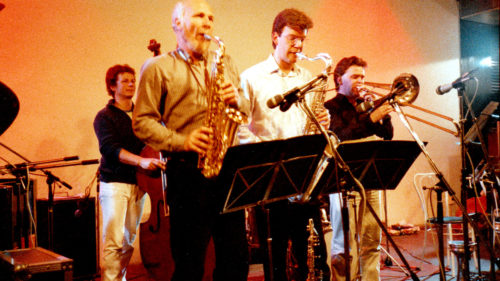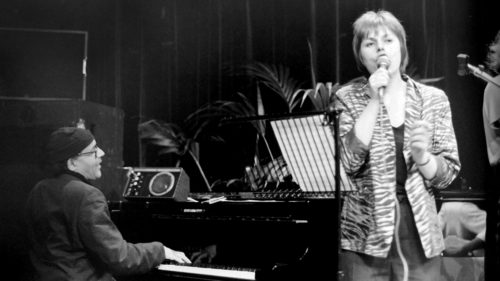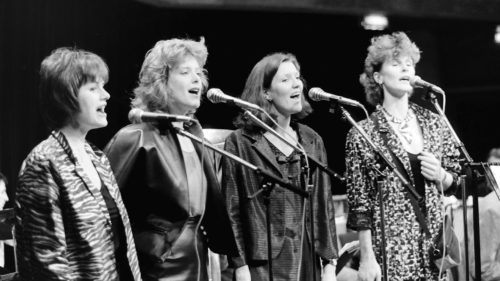NEW WAVES
jaartal: 1985
lengte: 87 min
logline:
When does sound become music? How does image influence what we hear? NEW WAVES, made on the occasion of the European Music Year 1985 explores and explains the differences and affinities between composed and improvised modern music in the Netherlands.
(source: catalogue American Film- and Video Festival)
synopsis:
The film NEW WAVES tries to provide an overview of the developments in contemporary musical life in the Netherlands. By moving around, the film shows the points of contact between composed and improvised music.
Performing musicians play an important role because they are sometimes involved with both of these forms of music and apparently cross over effortlessly.
There are also composers active in both of these areas, playing improvised music but writing serious pieces. Others endorse a way of working that is common in pop music. For example, one does not compose for an anonymous orchestra but for a specific group of which the composer knows all details and qualities.
In this film the project Kaalslag is followed. Four composers – Louis Andriessen, Cornelis de Bondt, Willem van Manen and Cees van Zeeland – each wrote a piece for the two cooperating orchestras: De Volharding and Hoketus.
Both orchestras have a tradition of working without a conductor, which results in a great involvement of all instrumentalists. Both also have clear ideas about the .repertoire that they wish to perform. Because of the short preparation time and the level of difficulty of some of the pieces, it was decided for Kaalslag to have the pieces conducted.
In addition to a number of similarities, there are also differences in the ideas and way of working between the four composers.
The film explores primarily the breadth of the terrain where written and im¬provised music meet each other, so that very diverse forms of music are dealt with. Musicians that one
moment perform music that has been written out note for note, appear later to be part of a funk band. Singing in a choir that is devoted to strict modern music does not get in the way of singing swinging improvised music.
To experience a concert in real life is different than seeing a fragment on film. The length of a piece of music is sometimes opposite to how a film treats time. But film has the possibility of editing available to it, through which images and sounds can be precisely arranged, and the diversity of what is now happening in music in the Netherlands can be approached.
When does sound become music? How does image – the film image – influence what we hear? The film plays with images and sounds, and makes visible the boundaries of the film medium.
The film tries to explain as little as possible. Rather, it tries to show as much as possible, in a cinematic form that attempts to sharpen eyes and ears.
New Waves has been made on the occasion of European music year as a joint venture of
Gaudeamus/Chris Walraven, Musica ’85/Sieuwert Verster, de IJsbreker/Jan Wolff
with grants from the ministry of culture WVC, the Prince Bernhard Fund, the Dutch copyright organisation Buma/Stemra and VPRO broadcasting association
with:
Maarten Altena – Louis Andriessen – ASKO-koor – Ab Baars – Leo Baatsen – René van den Berg – Peter van Bergen – Gilius van Bergeijk – Henk Bernlef – Beppie Blanken – Geert van Blokland – Lodewijk de Boer – Cornelis de Bondt – Alex Booy – Aad Bouwhuis – Gerard Bouwhuis – Willem Breuker – Fred Brinkman – Gene Carl – Jaap Dercksen – Peter van Dinther – Reijer Dorrestein – Bob Driessen – Martin van Duynhoven – Bert van Dijk – Niek van Dijk – Nedly Elstak – Huib Emmer – Dil Engelhard – Mea Flothuis – Renato Freyggang – Jeroen Goldsteen – Ad Groter – Jan Willem van de Ham – Jeff Hamburg – Liesbeth Harting – Willem Helwig – Hoketus – Simeon ten Holt – Guus Janssen – Paul Koek – Pim Koot – Henk Kraayenzank – Louis Lanzing – Peggy Larson – Reinbert de Leeuw – Jos Leussink – Theo Loevendie – Theo Loevendie Kwintet, met Errol Cemyl – Loos – Willem van Manen – Hans van der Meer – Ton van der Meer – Misha Mengelberg – Hans Meijdam – Carla Meijers – Viktor Miller – Jard van Nes – Piet Nieuwint – Leo van Oostrom – Hedwig Paesbrugge – Jeannette van der Pal – Eleonore Pameyer – Paradise Regained Orchestra – John Reinders – Residentie-Orkest – Camille Rorije – Mariëtte Rouppe van der Voort – Astrid Seriese – Pieter Smithuysen – Harry Spaniaay – Pien Stades – Frenk van der Sterre – Paul Termos -Tony Thijs – Wim Timmermans – Trebbel – Arielle Vemède – Lucas Vis – Hans Visser – De Volharding – Klaas de Vries – Diderik Wagenaar – Patricio Wang – Heleen van der Weel – Rombout Willems -Jeanette Yanikian – Cees van Zeeland en vele anderen
screenplay & direction: Digna Sinke
photography: Albert van der Wildt, Peter Brugman, Sjoerd Janssen
assistance & grip: Philip Hering, Marc Homs, Jessica Klijn, Wouter Suyderhoud
sound: Erik Langhout, Georges Bossaers, Victor Dekker, Menno Euwe,
Marcel de Hoogd
assistance: Els Mertens, Gusta van Eyk
original negative: Fujicolor
titles: Titra Film Laboratorium, 2M Filmgroep
title music: Willem Breuker/Spanish Wells (BV Haast 044)
processing: RCM Filmlab
production management: Conny Brak, Marjon van Schaik
editing: Jan Wouter van Reijen
mixing: JPS/Erik Langhout
producer: P. Hans Frankfurther / PAN film
première 9 oktober 1985
release: 17 oktober 1985
uitzending: 18 januari 1986
American Film- and Video Festival 27 mei – 1 juni 1986


